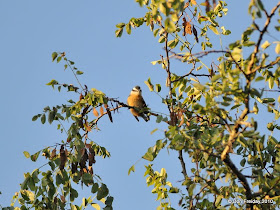Hotline: Cape May Birding Hotline
To Report: call (609) 884-2736, or email sightingsATbirdcapemay.org
Coverage: Cape May, Cumberland and Atlantic Counties , NJ
Compiler: David Lord, Cape May Bird Observatory with additions by Don Freiday
URL: http://www.njaudubon.org ; http://www.birdcapemay.org
This is the Cape May Birding Hotline, a service of New Jersey Audubon Society's Cape May Bird Observatory. This week's message was prepared on Thursday, August 19, 2010. Highlights this week include sightings of WESTERN KINGBIRD, BLACK-BELLIED WHISTLING DUCKS, KING EIDER, AMERICAN AVOCETS, LESSER BLACK-BACKED GULL, LAWRENCE’S AND GOLDEN-WINGED WARBLERS, and announcements about coming CMBO workshops.
-For up-to-the-minute Cape May sightings information, photos and downloadable birding maps and checklist of Cape May, visit www.birdcapemay.org . Follow rarity sightings, seasonal arrivals, and spectacles on www.twitter.com/CMBObirds -
A WESTERN KINGBIRD was reported from the South Cape May Meadows, a.k.a. TNC Cape May Migratory Bird Refuge, flying west towards the state park, on Thursday, August 19 2010.
3 BLACK-BELLIED WHISTLING DUCKS continue on Lighthouse Pond as of at least Tuesday, August 17, 2010. The whistling-ducks were not seen Thursday, August 19 as of 10:30 a.m., after Cape May received over 5 inches of rain the day prior, but may still be around.
The immature KING EIDER was seen on Saturday, August 14th, 2010, at Sunset Beach.
Two AMERICAN AVOCETS were seen at Bunker Pond on Tuesday, August 17th, 2010.
Two LESSER-BLACK BACKED GULLS were seen on the beach in front of the Meadows on Monday, August 16th, 2010.
A LAWRENCE’S WARBLER was near the dike at Higbee Beach WMA Thursday August 19, 2010, and a GOLDEN-WINGED WARBLER was in the second field at Higbee Beach the same day.
ANNOUNCEMENTS:
Space remains on a few CMBO fall birding workshops, including WARBLERS, VIREOS AND FLYCATCHERS August 24-25 with Louise Zemaitis; BIRDS IN FLIGHT September 4-5 with Michael O’Brien; FALL MIGRATION SAMPLER September 10-12 with Louise Zemaitis; and BIRD AND TREE I.D. September 20-21 with Don Freiday. Learn more at
http://www.birdcapemay.org/school.php or by calling 609.861.0700.
******CMBO FALL HOURS are as follows: Northwood Center on East Lake Drive in Cape May Point is open daily, 9:30 a.m. to 4:30 p.m. The Center for Research and Education on Rt. 47 in Goshen is open Tuesday through Saturday, 9:30am to 4:30pm; closed Sundays and Mondays. ******
The Cape May Birding Hotline is a service of the New Jersey Audubon Society's Cape May Bird Observatory and details sightings from Cape May, Cumberland and Atlantic Counties. Updates are made weekly. Please report sightings of rare or unusual birds to CMBO at 609-884-2736. Sponsorship for this hotline comes from the support of CMBO members and business members, and should you not be a member, we cordially invite you to join. Individual membership is $39 per year; $49 for families. You can call either center to become a member or visit. Become a member in person and you'll receive a FREE gift (in addition to member discounts in the stores).
Good Luck and Good Birding!
 [CMBO's 2010 Fall Migration Project team. Left to right, back row: Doug Gochfeld, Swing Counter; Andy Northrup, Seawatch/Hawkwatch Interpretive Naturalist; Tom Johnson, Morning Flight Counter. Left to right, front row: Ashley Green, Morning Flight/Hawk Watch Interpretive Naturalist; Jenny Howard, Monarch Migration Project Naturalist; Melissa Roach, Hawk Counter; Alyssia Church, Hawkwatch Interpretive Naturalist; Kaitlyn Marczi, George Myers Field Naturalist; Tiffany Kersten, Hawkwatch Interpretive Naturalist. Not pictured: Steve Kolbe, Seawatch Counter, who starts September 22.]
[CMBO's 2010 Fall Migration Project team. Left to right, back row: Doug Gochfeld, Swing Counter; Andy Northrup, Seawatch/Hawkwatch Interpretive Naturalist; Tom Johnson, Morning Flight Counter. Left to right, front row: Ashley Green, Morning Flight/Hawk Watch Interpretive Naturalist; Jenny Howard, Monarch Migration Project Naturalist; Melissa Roach, Hawk Counter; Alyssia Church, Hawkwatch Interpretive Naturalist; Kaitlyn Marczi, George Myers Field Naturalist; Tiffany Kersten, Hawkwatch Interpretive Naturalist. Not pictured: Steve Kolbe, Seawatch Counter, who starts September 22.]

















































